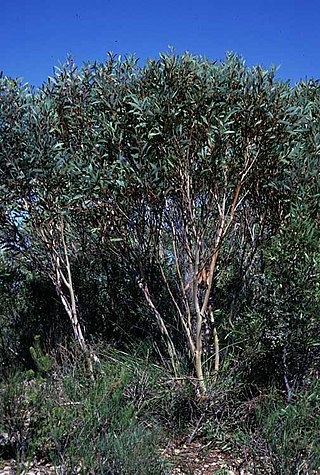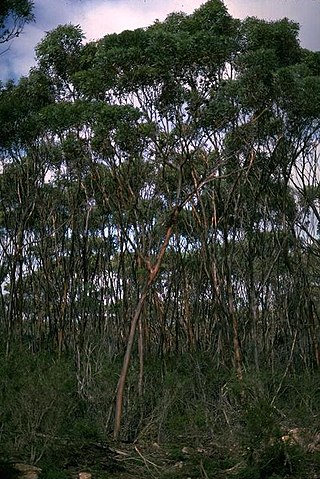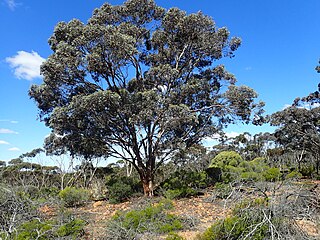
Eucalyptus zopherophloia, commonly known as the blackbutt mallee, is a species of spreading mallee that is endemic to an area on the west coast of Western Australia. It has rough bark over part or all of the trunk, smooth grey bark above, narrow lance-shaped leaves, flower buds in groups of nine or eleven, creamy white flowers and conical fruit.

Eucalyptus platypus, also known as moort or maalok, is a species of mallee or marlock that is endemic to the southwest of Western Australia. It has smooth bark, broadly elliptical to more or less round adult leaves, flower buds in groups of nine on a broad, flattened peduncle, usually creamy white flowers and conical, down-turned fruit.
Eucalyptus arborella, commonly known as Twertup mallet, is a mallet or small tree that is endemic to a small area in the south-west of Western Australia. It has smooth greyish bark, narrow lance-shaped adult leaves, flower buds in groups of thirteen to twenty fused together, yellowish green flowers, and fruits fused together in a woody mass.

Eucalyptus calyerup is a tree that is endemic to a small area in the south-west of Western Australia. It has rough, fibrous bark on the lower part of the trunk, smooth bark above, elliptic to lance-shaped adult leaves, flower buds in groups of seven, creamy-yellow flowers and conical to bell-shaped fruit.

Eucalyptus erectifolia, commonly known as Stirling Range mallee, is a species of mallee that is endemic to Western Australia. It has smooth bark, narrow lance-shaped adult leaves, flower buds in groups of between seven and thirteen, white flowers and cup-shaped fruit.
Eucalyptus famelica is a species of mallee that is endemic to Western Australia. It has smooth grey and pale brown bark, sometimes with thin, rough, fibrous bark near the base of the trunk on larger plants. The adult leaves are lance-shaped, the flower buds are arranged in groups of seven, the flowers are creamy white and the fruit is cup-shaped to cylindrical.
Eucalyptus glomerosa, commonly known as jinjulu, is a species of mallee that is endemic to inland Australia. It has rough, fibrous and flaky bark near the base, smooth bark above, egg-shaped to lance-shaped adult leaves, flower buds usually in groups of seven, cream-coloured flowers and conical to hemispherical fruit. It is mainly found in the Great Victoria Desert of South Australia but also grows in eastern parts of Western Australia.
Eucalyptus histophylla is a species of mallee or small tree that is endemic to southern Western Australia. It has smooth bark, often with ribbons of shed bark, linear to narrow lance-shaped adult leaves, flower buds arranged in groups in leaf axils, white flowers and cylindrical to barrel-shaped or conical fruit.
Eucalyptus melanophitra is a species of mallet that is endemic to a restricted area of Western Australia. It has rough, flaky grey bark on the trunk, smooth grey bark above, narrow lance-shaped adult leaves, flower buds in groups of nine or eleven, pale yellow flowers and cylindrical to barrel-shaped fruit.
Eucalyptus mimica is a species of mallet that is endemic to a small area of Western Australia. It has smooth, shiny bark, linear to narrow elliptical leaves held erect, flower buds in groups of three and conical fruit with ribbed sides.

Eucalyptus newbeyi, commonly known as Beaufort Inlet mallee, is a species of mallee that is endemic to a small area on the south coast of Western Australia. It has smooth, mottled bark, narrow leaves, flower buds usually in groups of seven, yellowish green flowers and bell-shaped to conical fruit.

Eucalyptus nutans, commonly known as red-flowered moort, is a species of mallet that is endemic to a small area near the south coast of Western Australia. It has smooth bark, oblong to almost round adult leaves, flower buds in groups of seven, red or pinkish flowers and cup-shaped to conical fruit.

Eucalyptus phaenophylla, also known as common southern mallee, is a species of mallee that is endemic to Western Australia. It has smooth bark, linear to narrow lance-shaped or narrow elliptical adult leaves, flower buds in groups of up to thirteen, pale lemon-coloured flowers and barrel-shaped, cylindrical or conical fruit.

Eucalyptus sporadica, commonly known as the Burngup mallee, is a species of mallee that is endemic to the southwest of Western Australia. It has smooth bark, lance-shaped adult leaves, flower buds in groups of seven, yellowish flowers and down-turned, conical to cylindrical fruit.
Eucalyptus suggrandis is a species of mallee that is endemic to the southwest of Western Australia. It has smooth, shiny bark, linear to elliptical leaves, flower buds in groups of three or seven, creamy white flowers and cup-shaped to conical fruit.

Eucalyptus utilis, commonly known as coastal moort or coastal mort, is a species of mallet or mallee that is native to southern areas of Western Australia. It has smooth bark, egg-shaped to lance-shaped adult leaves, flower buds in group or seven, creamy white flowers and conical fruit.
Eucalyptus vegrandis, commonly known as the Ongerup mallee or Cranbrook mallee, is a species of mallee that is endemic to the south-west of Western Australia. It has smooth bark, linear to lance-shaped adult leaves, flower buds in groups of seven, creamy white flowers and cup-shaped or conical fruit.

Eucalyptus clivicola, commonly known as green mallet, is a species of eucalypt that is endemic to Western Australia. It has smooth bark, linear to lance-shaped adult leaves, flower buds in groups of between nine and thirteen, pale yellow flowers and barrel-shaped, conical or cylindrical fruit.

Eucalyptus densa is a species of mallee or mallet that is endemic to Western Australia. It has smooth greyish bark that is shed in curly strips, linear to narrow lance-shaped adult leaves, long, spindle-shaped flower buds in groups of seven or nine, pale yellow or lemon-coloured flowers and conical, cylindrical or barrel-shaped fruit.
Eucalyptus rhomboidea, commonly known as the diamond gum, is a species of mallet or tree that is endemic to the southwest of Western Australia. It has smooth bark, lance-shaped adult leaves, flower buds in groups of seven, pale yellow flowers and cup-shaped to funnel-shaped fruit that is glaucous at first.












